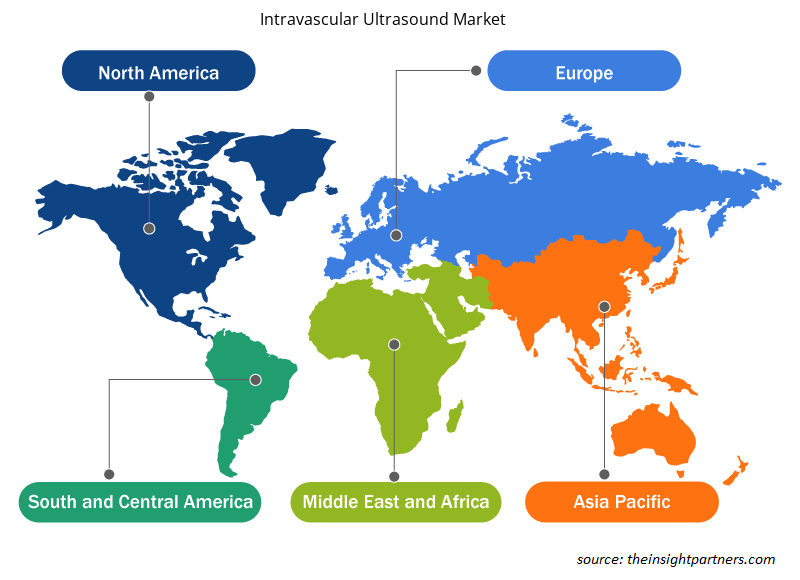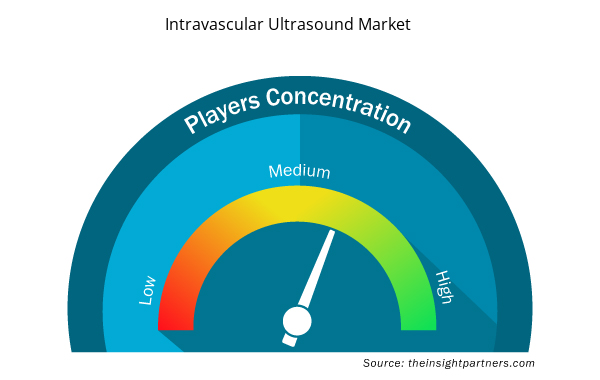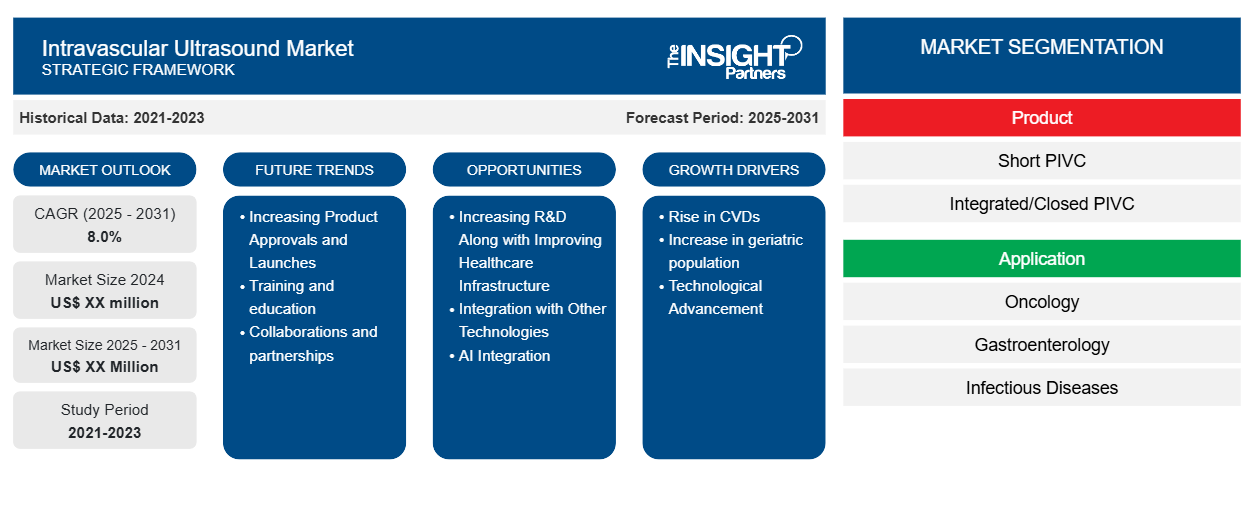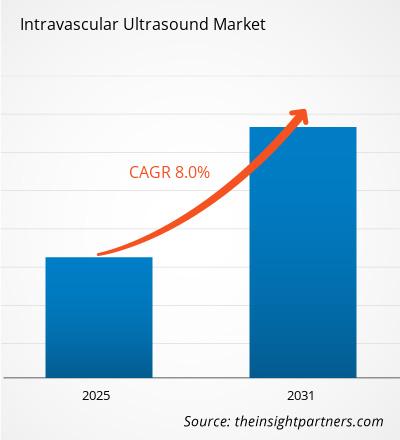Der Markt für intravaskulären Ultraschall wird voraussichtlich von 2023 bis 2031 eine durchschnittliche jährliche Wachstumsrate (CAGR) von 8,0 % verzeichnen, wobei die Marktgröße von XX Millionen US-Dollar im Jahr 2023 auf XX Millionen US-Dollar bis 2031 wachsen wird.
Der Bericht ist nach Produkt segmentiert (Short PIVC, Integrated/Closed PIVC). Darüber hinaus ist der Markt nach Anwendung segmentiert (Onkologie, Gastroenterologie, Infektionskrankheiten, Nierenkrankheiten, Sonstige). Der Bericht ist nach Endbenutzer segmentiert (Krankenhäuser, Kliniken, ambulante chirurgische Zentren, Sonstige). Die globale Analyse ist weiter auf regionaler Ebene und nach wichtigen Ländern aufgeschlüsselt. Der Bericht bietet den Wert in USD für die oben genannte Analyse und Segmente.
Zweck des Berichts
Der Bericht „Intravaskulärer Ultraschallmarkt“ von The Insight Partners soll die aktuelle Situation und das zukünftige Wachstum sowie die wichtigsten treibenden Faktoren, Herausforderungen und Chancen beschreiben. Dies wird verschiedenen Geschäftspartnern Einblicke geben, wie zum Beispiel:
- Technologieanbieter/-hersteller: Um die sich entwickelnde Marktdynamik zu verstehen und die potenziellen Wachstumschancen zu kennen, damit sie fundierte strategische Entscheidungen treffen können.
- Investoren: Durchführung einer umfassenden Trendanalyse hinsichtlich der Marktwachstumsrate, der finanziellen Marktprognosen und der Chancen entlang der Wertschöpfungskette.
- Regulierungsbehörden: Zur Regulierung von Richtlinien und Überwachungsaktivitäten auf dem Markt mit dem Ziel, Missbrauch zu minimieren, das Vertrauen der Anleger zu bewahren und die Integrität und Stabilität des Marktes aufrechtzuerhalten.
Intravaskulärer Ultraschall Marktsegmentierung
Produkt
- Kurzes PIVC
- Integrierter/geschlossener PIVC
Anwendung
- Onkologie
- Gastroenterologie
- Infektionskrankheiten
- Nierenerkrankungen
- Sonstiges
Endbenutzer
- Krankenhäuser
- Kliniken
- Ambulante Chirurgische Zentren
- Sonstiges
Geographie
- Nordamerika
- Europa
- Asien-Pazifik
- Süd- und Mittelamerika
- Naher Osten und Afrika
Geographie
- Nordamerika
- Europa
- Asien-Pazifik
- Süd- und Mittelamerika
- Naher Osten und Afrika
Passen Sie diesen Bericht Ihren Anforderungen an
Sie erhalten kostenlose Anpassungen an jedem Bericht, einschließlich Teilen dieses Berichts oder einer Analyse auf Länderebene, eines Excel-Datenpakets sowie tolle Angebote und Rabatte für Start-ups und Universitäten.
- Holen Sie sich die wichtigsten Markttrends aus diesem Bericht.Dieses KOSTENLOSE Beispiel umfasst eine Datenanalyse von Markttrends bis hin zu Schätzungen und Prognosen.
Wachstumstreiber auf dem Markt für intravaskulären Ultraschall
- Anstieg von Herz-Kreislauf-Erkrankungen: Herz-Kreislauf-Erkrankungen (CVDs) sind weiterhin die weltweit bedeutendste Ursache für Morbidität und Mortalität. CVDs betreffen Herz und Blutgefäße und umfassen koronare Herzkrankheiten, Arrhythmien und andere Erkrankungen. Laut der Weltgesundheitsorganisation sind CVDs beispielsweise die weltweit häufigste Todesursache und fordern jedes Jahr schätzungsweise 17,9 Millionen Menschenleben. Laut den Centers of Disease Control and Prevention leidet etwa jeder 20. Erwachsene im Alter von 20 Jahren und älter an einer koronaren Herzkrankheit. Die Mehrheit der CVDs kann durch Vorüberwachung und Vordiagnose mit intravaskulären Ultraschallgeräten verhindert werden. Daher treibt die wachsende Zahl von CVDs die Nachfrage nach intravaskulären Ultraschallgeräten voran.
- Zunahme der geriatrischen Bevölkerung: Aufgrund altersbedingter Herzveränderungen, Komorbiditäten und Polypharmazie ist die wachsende geriatrische Bevölkerung am stärksten von Herzrhythmusstörungen bedroht. Patienten dieser Altersgruppe leiden unter Bluthochdruck, Herzinsuffizienz, Diabetes und vielen anderen Krankheiten, die das Risiko von Herzrhythmusstörungen erhöhen. Die physiologische Alterung des Herzens ist aufgrund des erhöhten oxidativen Stresses und der Entzündungen ein wesentlicher ursächlicher Faktor für das Auftreten und die Manifestation von Herz-Kreislauf-Erkrankungen bei älteren Erwachsenen. Daher erfordert der weltweite Anstieg der älteren Bevölkerung intravaskuläre Ultraschallgeräte (IVUS) und treibt damit das Marktwachstum an.
- Technologischer Fortschritt: Moderne Bildgebungsverfahren bieten höhere Auflösung und klarere Bilder für eine bessere Diagnose. IVUS-Geräte werden jetzt mit anderen Bildgebungsverfahren wie OCT integriert, was einen besseren Einblick in Eingriffe ermöglicht. Katheter werden miniaturisiert und flexibler gemacht, um einfachere Manöver ohne Unannehmlichkeiten für den Patienten zu ermöglichen. Dieser technologische Fortschritt verändert die Funktion und den Nutzen von IVUS in der Klinik.
Zukünftige Trends auf dem Markt für intravaskulären Ultraschall
- Zunehmende Produktzulassungen und -einführungen: Der Markt für intravaskuläre Ultraschallgeräte ist durch die Präsenz großer und kleiner Unternehmen gekennzeichnet. Um ihren Marktanteil zu erhöhen, verfolgen Marktteilnehmer verschiedene Strategien wie die Einführung neuer Produkte, regionale Expansion und technologische Fortschritte. Intravaskuläre Ultraschallgeräte sind durch kontinuierliche Innovationen und technologische Fortschritte sicherer und effektiver, was zu einer höheren Akzeptanz führt. Führende Akteure investieren in Forschung und Entwicklung, um fortschrittliche Technologien zu entwickeln und mehr Umsatz zu erzielen.
- Schulung und Ausbildung: Schulung und Ausbildung sind auch ein Schlüssel zur Verbesserung der Fähigkeiten und zur Erzielung der besten Ergebnisse bei Patienten im Bereich des intravaskulären Ultraschalls. Berufsverbände bieten häufig Zertifizierungskurse an, um die Kompetenz von Klinikern bei der Durchführung von intravaskulären Ultraschalluntersuchungen zu bestätigen und so das Wissen und die Fähigkeiten der Kliniker zu standardisieren. Ausgefeilte Simulatoren bieten Übungen in einer risikofreien Umgebung, sodass Benutzer ihre Fähigkeiten in der Bildinterpretation und im Verfahrensmanagement verfeinern können.
- Kooperationen und Partnerschaften: Kooperationen und Partnerschaften auf dem Markt für intravaskulären Ultraschall (IVUS) haben als wichtiger Impulsgeber für Innovation und die Ausweitung der Marktreichweite gedient. Intrakoronare und extrakardiale Kooperationen zwischen Medizintechnikunternehmen und Technologieunternehmen ebnen den Weg für die Entwicklung anspruchsvoller IVUS-Systeme, kombiniert mit modernsten Bildgebungstechnologien und KI. Ebenso verbessern Kooperationen mit Krankenhäusern und Kliniken die Schulungsprogramme und bieten Ärzten Zugang zu den neuesten IVUS-Technologien und Best Practices. Die Partnerschaften treiben die ultimative Entwicklung und Implementierung von IVUS-Technologien voran und verbessern so die Pflege und Behandlung von Patienten sowie das Wachstum im kardiovaskulären Sektor.
Marktchancen für intravaskulären Ultraschall
- Steigerung von F&E bei gleichzeitiger Verbesserung der Gesundheitsinfrastruktur: Innovationen in den Bereichen KI und maschinelles Lernen verbessern in hohem Maße die Fähigkeit von CRM-Geräten, bessere Datenanalysen, prädiktive Analysen und eine personalisierte Patientenversorgung zu bieten. Computer ermöglichen eine bessere und detailliertere Erkennung unregelmäßiger Herzrhythmen für frühere und genauere Diagnosen. Dies ist ein technologisches Gerät, und die Maschine wird Daten sammeln und analysieren, was die Patientenbehandlung und -ergebnisse verbessern kann. In den Gesundheitsmärkten kommt die hohe Nachfrage nach KI-basiertem Herzrhythmusmanagement hauptsächlich von drei zentralen Faktoren: Technologie, Gesundheitsbewusstsein und vorbeugende Versorgung.
- Integration mit anderen Technologien: Die Integration von IVUS mit anderen Technologien hat das diagnostische und therapeutische Potenzial in der kardiovaskulären Versorgung verbessert. In Kombination mit OCT hilft die Integration, höhere Auflösungen der Gefäßwand- und Lumenbilder zu erreichen und so detaillierte Informationen zur Zusammensetzung und Struktur von Plaques zu erhalten. Eine Echtzeitvisualisierung der Gefäßstruktur ist möglich, wenn IVUS mit 3D-Mapping-Systemen integriert wird.
- KI-Integration: KI kann Merkmale wie Plaquemerkmale von IVUS identifizieren, was sehr hilfreich sein kann, um die Zusammensetzung der Plaque zu verstehen, was wiederum Hinweise auf eine Risikostratifizierung und Behandlungsplanung gibt. Die Integration von Datenanalysen kann prädiktive Modelle für die Behandlungsergebnisse bei Patienten erstellen. KI kann die Entscheidungsfindung in Echtzeit während Eingriffen erleichtern und Ärzten dabei helfen, angemessene Entscheidungen bezüglich der Platzierung des Stents und der Interventionsstrategie zu treffen.
Regionale Einblicke in den Markt für intravaskulären Ultraschall
Die regionalen Trends und Faktoren, die den Markt für intravaskuläre Ultraschalluntersuchungen im Prognosezeitraum beeinflussen, wurden von den Analysten von Insight Partners ausführlich erläutert. In diesem Abschnitt werden auch die Marktsegmente und die Geografie für intravaskuläre Ultraschalluntersuchungen in Nordamerika, Europa, im asiatisch-pazifischen Raum, im Nahen Osten und Afrika sowie in Süd- und Mittelamerika erörtert.

- Erhalten Sie regionale Daten zum Markt für intravaskuläre Ultraschalluntersuchungen
Umfang des Marktberichts zum intravaskulären Ultraschall
| Berichtsattribut | Details |
|---|---|
| Marktgröße im Jahr 2023 | XX Millionen US-Dollar |
| Marktgröße bis 2031 | XX Millionen US-Dollar |
| Globale CAGR (2023 - 2031) | 8,0 % |
| Historische Daten | 2021-2022 |
| Prognosezeitraum | 2024–2031 |
| Abgedeckte Segmente | Nach Produkt
|
| Abgedeckte Regionen und Länder | Nordamerika
|
| Marktführer und wichtige Unternehmensprofile |
|
Dichte der Marktteilnehmer für intravaskulären Ultraschall: Die Auswirkungen auf die Geschäftsdynamik verstehen
Der Markt für intravaskuläre Ultraschalluntersuchungen wächst rasant, angetrieben durch die steigende Nachfrage der Endnutzer aufgrund von Faktoren wie sich entwickelnden Verbraucherpräferenzen, technologischen Fortschritten und einem größeren Bewusstsein für die Vorteile des Produkts. Mit steigender Nachfrage erweitern Unternehmen ihr Angebot, entwickeln Innovationen, um die Bedürfnisse der Verbraucher zu erfüllen, und nutzen neue Trends, was das Marktwachstum weiter ankurbelt.
Die Marktteilnehmerdichte bezieht sich auf die Verteilung der Firmen oder Unternehmen, die in einem bestimmten Markt oder einer bestimmten Branche tätig sind. Sie gibt an, wie viele Wettbewerber (Marktteilnehmer) in einem bestimmten Marktraum im Verhältnis zu seiner Größe oder seinem gesamten Marktwert präsent sind.
Die wichtigsten auf dem Markt für intravaskulären Ultraschall tätigen Unternehmen sind:
- ALLGEMEINE ELEKTRIK
- Koninklijke Philips NV
- CANON MEDICAL SYSTEMS CORPORATION
- Siemens AG
- TERUMO CORPORATION
Haftungsausschluss : Die oben aufgeführten Unternehmen sind nicht in einer bestimmten Reihenfolge aufgeführt.

- Überblick über die wichtigsten Akteure auf dem Markt für intravaskulären Ultraschall
Wichtige Verkaufsargumente
- Umfassende Abdeckung: Der Bericht deckt die Analyse von Produkten, Dienstleistungen, Typen und Endbenutzern des Marktes für intravaskulären Ultraschall umfassend ab und bietet einen ganzheitlichen Überblick.
- Expertenanalyse: Der Bericht basiert auf dem umfassenden Verständnis von Branchenexperten und Analysten.
- Aktuelle Informationen: Der Bericht stellt durch die Abdeckung aktueller Informationen und Datentrends Geschäftsrelevanz sicher.
- Anpassungsoptionen: Dieser Bericht kann angepasst werden, um spezifische Kundenanforderungen zu erfüllen und die Geschäftsstrategien optimal anzupassen.
Der Forschungsbericht zum Markt für intravaskulären Ultraschall kann daher dabei helfen, die Branchensituation und Wachstumsaussichten zu entschlüsseln und zu verstehen. Obwohl es einige berechtigte Bedenken geben kann, überwiegen die allgemeinen Vorteile dieses Berichts tendenziell die Nachteile.
- Historische Analyse (2 Jahre), Basisjahr, Prognose (7 Jahre) mit CAGR
- PEST- und SWOT-Analyse
- Marktgröße Wert/Volumen – Global, Regional, Land
- Branche und Wettbewerbsumfeld
- Excel-Datensatz


- Real-Time Location Systems Market
- Analog-to-Digital Converter Market
- Nuclear Waste Management System Market
- Identity Verification Market
- Single-Use Negative Pressure Wound Therapy Devices Market
- Fertilizer Additives Market
- Foot Orthotic Insoles Market
- Microplate Reader Market
- Europe Industrial Chillers Market
- Mail Order Pharmacy Market

Report Coverage
Revenue forecast, Company Analysis, Industry landscape, Growth factors, and Trends

Segment Covered
This text is related
to segments covered.

Regional Scope
North America, Europe, Asia Pacific, Middle East & Africa, South & Central America

Country Scope
This text is related
to country scope.
Häufig gestellte Fragen
Integrated/Closed PIVC segment, by product, dominated the market in 2023.
Players operating in the market are General Electric, Koninklijke Philips, Canon Medical Systems, Siemens AG, Terumo Corp, Hitachi Ltd, Fujifilm Holdings, and Samsung Medison Co., Ltd.
North America region dominated the Intravascular Ultrasound market in 2023.
Increasing R&D Along with Improving Healthcare Infrastructure act as a opportunity for growth of the market in forecast period.
The Intravascular Ultrasound Market is estimated to witness a CAGR of 8.0% from 2023 to 2031
The major factors driving the Intravascular Ultrasound market are:
1. Rise in CVDs
2. Increase in geriatric population
Trends and growth analysis reports related to Life Sciences : READ MORE..
1. GENERAL ELECTRIC
2. Koninklijke Philips N.V.
3. CANON MEDICAL SYSTEMS CORPORATION
4. Siemens AG
5. TERUMO CORPORATION
6. Hitachi, Ltd.
7. Samsung Medison Co., Ltd.
8. Shenzhen Mindray Bio-Medical Electronics Co., Ltd.
9. Fujifilm Holdings Corporation
10. Infraredx, Inc.
The Insight Partners performs research in 4 major stages: Data Collection & Secondary Research, Primary Research, Data Analysis and Data Triangulation & Final Review.
- Data Collection and Secondary Research:
As a market research and consulting firm operating from a decade, we have published and advised several client across the globe. First step for any study will start with an assessment of currently available data and insights from existing reports. Further, historical and current market information is collected from Investor Presentations, Annual Reports, SEC Filings, etc., and other information related to company’s performance and market positioning are gathered from Paid Databases (Factiva, Hoovers, and Reuters) and various other publications available in public domain.
Several associations trade associates, technical forums, institutes, societies and organization are accessed to gain technical as well as market related insights through their publications such as research papers, blogs and press releases related to the studies are referred to get cues about the market. Further, white papers, journals, magazines, and other news articles published in last 3 years are scrutinized and analyzed to understand the current market trends.
- Primary Research:
The primarily interview analysis comprise of data obtained from industry participants interview and answers to survey questions gathered by in-house primary team.
For primary research, interviews are conducted with industry experts/CEOs/Marketing Managers/VPs/Subject Matter Experts from both demand and supply side to get a 360-degree view of the market. The primary team conducts several interviews based on the complexity of the markets to understand the various market trends and dynamics which makes research more credible and precise.
A typical research interview fulfils the following functions:
- Provides first-hand information on the market size, market trends, growth trends, competitive landscape, and outlook
- Validates and strengthens in-house secondary research findings
- Develops the analysis team’s expertise and market understanding
Primary research involves email interactions and telephone interviews for each market, category, segment, and sub-segment across geographies. The participants who typically take part in such a process include, but are not limited to:
- Industry participants: VPs, business development managers, market intelligence managers and national sales managers
- Outside experts: Valuation experts, research analysts and key opinion leaders specializing in the electronics and semiconductor industry.
Below is the breakup of our primary respondents by company, designation, and region:

Once we receive the confirmation from primary research sources or primary respondents, we finalize the base year market estimation and forecast the data as per the macroeconomic and microeconomic factors assessed during data collection.
- Data Analysis:
Once data is validated through both secondary as well as primary respondents, we finalize the market estimations by hypothesis formulation and factor analysis at regional and country level.
- Macro-Economic Factor Analysis:
We analyse macroeconomic indicators such the gross domestic product (GDP), increase in the demand for goods and services across industries, technological advancement, regional economic growth, governmental policies, the influence of COVID-19, PEST analysis, and other aspects. This analysis aids in setting benchmarks for various nations/regions and approximating market splits. Additionally, the general trend of the aforementioned components aid in determining the market's development possibilities.
- Country Level Data:
Various factors that are especially aligned to the country are taken into account to determine the market size for a certain area and country, including the presence of vendors, such as headquarters and offices, the country's GDP, demand patterns, and industry growth. To comprehend the market dynamics for the nation, a number of growth variables, inhibitors, application areas, and current market trends are researched. The aforementioned elements aid in determining the country's overall market's growth potential.
- Company Profile:
The “Table of Contents” is formulated by listing and analyzing more than 25 - 30 companies operating in the market ecosystem across geographies. However, we profile only 10 companies as a standard practice in our syndicate reports. These 10 companies comprise leading, emerging, and regional players. Nonetheless, our analysis is not restricted to the 10 listed companies, we also analyze other companies present in the market to develop a holistic view and understand the prevailing trends. The “Company Profiles” section in the report covers key facts, business description, products & services, financial information, SWOT analysis, and key developments. The financial information presented is extracted from the annual reports and official documents of the publicly listed companies. Upon collecting the information for the sections of respective companies, we verify them via various primary sources and then compile the data in respective company profiles. The company level information helps us in deriving the base number as well as in forecasting the market size.
- Developing Base Number:
Aggregation of sales statistics (2020-2022) and macro-economic factor, and other secondary and primary research insights are utilized to arrive at base number and related market shares for 2022. The data gaps are identified in this step and relevant market data is analyzed, collected from paid primary interviews or databases. On finalizing the base year market size, forecasts are developed on the basis of macro-economic, industry and market growth factors and company level analysis.
- Data Triangulation and Final Review:
The market findings and base year market size calculations are validated from supply as well as demand side. Demand side validations are based on macro-economic factor analysis and benchmarks for respective regions and countries. In case of supply side validations, revenues of major companies are estimated (in case not available) based on industry benchmark, approximate number of employees, product portfolio, and primary interviews revenues are gathered. Further revenue from target product/service segment is assessed to avoid overshooting of market statistics. In case of heavy deviations between supply and demand side values, all thes steps are repeated to achieve synchronization.
We follow an iterative model, wherein we share our research findings with Subject Matter Experts (SME’s) and Key Opinion Leaders (KOLs) until consensus view of the market is not formulated – this model negates any drastic deviation in the opinions of experts. Only validated and universally acceptable research findings are quoted in our reports.
We have important check points that we use to validate our research findings – which we call – data triangulation, where we validate the information, we generate from secondary sources with primary interviews and then we re-validate with our internal data bases and Subject matter experts. This comprehensive model enables us to deliver high quality, reliable data in shortest possible time.


 Holen Sie sich ein kostenloses Muster für diesen Bericht
Holen Sie sich ein kostenloses Muster für diesen Bericht